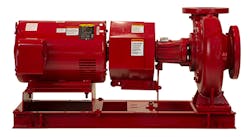Latest from Commercial Plumbing
Sponsored
DOE issues rule on pump efficiency standards
On Dec. 31, 2015, the U.S. Department of Energy (DOE) issued its final rule on energy conservation standards for commercial and industrial water pumps.
This rule will reduce pump operating costs for building owners and reduce carbon emissions related to power generation, but will also have a significant impact on pump manufacturers and their customers, due to the cost of pump hydraulic redesign, testing and new materials.
Manufacturers have been anticipating the changes since the first steps to put industry standards in place began in 2011. Prior to this rule, there had been no federal standards or test procedures for commercial and industrial pumps. The DOE has determined the new standards will result in significant conservation of energy and that they are technologically feasible and economically justified.
Pump industry experts, engaged in the Hydraulic Institute (HI), have worked closely with the DOE through this years-long rulemaking process, offering unprecedented cooperation among government, environmental and industry leaders. With an estimated 20 percent or more of the electricity in the United States consumed by commercial and industrial water pumps, manufacturers acknowledge the need to create more energy-efficient products. HI, representing more than 450 pump manufacturers in 38 states, has worked to ensure the regulations do not create financial hardships for its members while still meeting efficiency standards.
Although some U.S. manufacturers have taken steps toward the goal of greater efficiency through portfolio redesign, the lack of federal regulation has created inconsistency across the industry. The new regulations are modeled after those put in place in the European Union in 2009. HI’s Pump Efficiency Expert Team, known as PEET, provided the DOE with extensive research about EU standards and other primary efficiency data relevant to the proposed changes.
HI’s far-reaching involvement included representation on the DOE Appliance Standards and Rulemaking Federal Advisory Committee (ASRAC) Commercial and Industrial Pumps Working Group. Members of this group represented pump manufacturers, trade associations, customers, motor manufacturers and efficiency advocates, and were tasked with developing pump efficiency and testing recommendations for the DOE.
After seven sets of meetings between December 2013 and June 2014, the Pumps Working Group presented the DOE ASRAC Committee with 14 recommendations, including the development of test procedures, labels and energy conservation standards that only target pumps designated for use in pumping clean water. While the pump efficiency standards guidelines include pump motors, these motors are already subject to separate energy conservation standards and are not being further regulated as part of this initiative. The new DOE standards address up to 70 percent of commercial and industrial pump energy use.
Compliance will be costly for some, but manufacturers are committed to efficiency improvements. To that end, manufacturers are choosing to retire lower efficiency pumps and are redesigning or retooling existing lines. Some U.S. pump manufacturers have been deep into research and development the last few years and are already rolling out new, highly efficient products. Aside from domestic compliance, these measures keep the U.S. pump industry competitive in the world marketplace where more stringent European standards are already in place.
The effective date of the new rule will be 60 days after the date of publication in the Federal Register and compliance is required four years after the date of publication in the Federal Register. Although the new rule doesn’t address increasing levels of efficiency compliance, it’s generally understood within the industry that this rule is the first step in a continuing escalation of efficiency.
By working together and integrating the insights and needs of the industry from the perspective of manufacturers and other key players, these new standards will reduce electrical demand and improve overall efficiency of pumps in the U.S.
Mark Handzel is vice president, product regulatory affairs, and director, HVAC commercial buildings, Bell & Gossett, a Xylem Brand. He is a member of the Appliance Standards and Rulemaking Federal Advisory Committee’s Commercial and Industrial Pumps Working Group.



